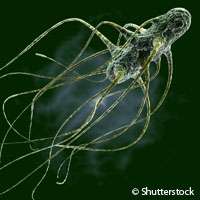BIOTRACER model tackles Salmonella

Protecting consumers from contaminated foods is one of the most important objectives of the EU. Helping drive this effort is the BIOTRACER ('Improved bio-traceability of unintended microorganisms and their substances in food and feed chains') project, which received EUR 11 million under the 'Food quality and safety' Thematic area of the EU's Sixth Framework Program (FP6) to probe the main sources of contamination.
Salmonella infections, for example, are not uncommon in cases of food-borne gastroenteritis in people. Eggs, fresh produce and meat may be involved in triggering such infections. Experts believe that at least 2 in 20 people diagnosed with salmonellosis 'catch it' from contaminated pork products. The latest development in the BIOTRACER project is a tool for modelling and predicting the growth of Salmonella in the pork chain supply. This tool is presented in the International Journal of Food Microbiology.
The BIOTRACER consortium, which consists of 47 research, academic and industry experts from 22 countries, said that identifying the source of bacterial contamination to a specific supply chain stage is no easy task. The main problem is determining how the bacteria grow at various stages and under diverse environmental conditions.
Leading the development was the BIOTRACER partner, the Institute of Food Research in the United Kingdom. Working together with Greek and Italian experts, the group created a model demonstrating how each step in the production process affects Salmonella growth.
The growth and survival of Salmonella is contingent on various factors including pH conditions, water activity and temperature, which change during the pork processing stages, according to the partners. The team pointed out that information about Salmonella growth in diverse conditions was generated by many researchers and compiled in different databases. Combase, developed by the Institute of Food Research in cooperation with the United States Department of Agriculture (USDA) Agricultural Research Service and the Food Safety Centre in Australia, is such a database, an open-access repository for quantitative microbiological data.
The BIOTRACER partners found more than 700 records in the Combase database describing Salmonella growth specifically for the supply chain of pork. They also combined various models to generate estimates on the concentrations of Salmonella at various stages of the pork supply chain, taking into account pH conditions, water activity and changes in temperature. A number of products were used to validate the estimates.
A unique feature of the models is that users can enter their own conditions and get an estimate of the Salmonella concentrations at various process stages. With this information, users fuel their understanding of what steps are needed in the supply chain of pork and contribute to the improved control of Salmonella and safe food production, project partners explained.
More information: Pin, C., et al. (2011) Intl Jrnl of Food Microbiology 145: 96-102. DOI:10.1016/j.ijfoodmicro.2010.09.025.
Provided by CORDIS
















